Just bear in mind that the paint strokes will look different than the ones done with a brush.
Best Acrylic Painting Tools And How To Use Them Creatively
Acrylic painting tools are the easiest ones to use in my experience (compared to oil painting tools). The beauty of acrylic paint allows you to use different tools, even DIY ones, and get interesting results.
I’ll be sharing basic and simple acrylic painting tools for beginners, especially art journalers. You won’t have to spend a lot of money, and I’m sure you already have many things around your home for acrylic painting.
Also, you’ll get tips for using these tools – how to get the best out of them, plus where to get them.
Basic acrylic painting tools
Let’s go over the basic and optional tools for painting with acrylics.
By basic, I mean that everyone should have these when using acrylics, whether you’re a beginner or an advanced artist.
The basic acrylic painting tools:
Not too many, right?
Disclaimer: Some links in this post may be affiliate links. This means that if you purchase something through that link, I get a small commission, at no extra cost to you.
Paintbrushes

There are many types and sizes of paintbrushes, but if you’re just starting, you can get flat brushes because they work great with acrylic paint.
Also, filbert paint brushes are great for getting more details without creating hard edges.
Think about what you’re planning on painting. If you need a brush for the background, choose a larger, flat brush – size 20 and up.
If you want to add marks or details, get a filbert brush in a smaller size like 6, 8, or 10.
Paint palette
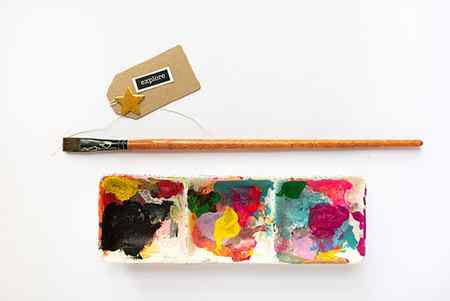
What’s good about acrylic paint palettes is that when the paint is dry, you can add a different paint on top without activating the first, dry layer.
That’s why I stopped washing my palettes. I was just lazy, washing them took me away from the actual creating, so I just stopped.
However, I’m careful with the amount of paint I squeeze out, I don’t want to waste it. So, if you’re like me and don’t like cleaning, just don’t add too much paint at once so you don’t waste it.
Water jars
This one is really simple and self-explanatory. Just get a jar or a mug that you don’t use anymore, and fill it with water.
The only advice I’d give here is to choose a jar nig enough so you can add enough water. If you choose something small, even one brush dip will make the water dirty.
Even more, you can have two jars and clean your brushes in both. This saves you time from going to the sink to change the water.
Optional acrylic painting tools
And here’s where the fun begins. You can use many things to paint with acrylics that can boost your creativity and inspire you in a lot of ways.
Or, these tools can make your life easier (because they’re neat practical things).
Sponge/foam brushes
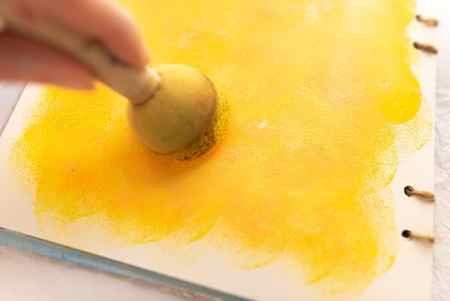
Basically, these are sponges with a holder. They need to be firm enough to spread the paint. But if you water down your paint, they are a marvelous tool to use.
They can be great for covering larger areas and you can also use them with stencils.
Painting knife
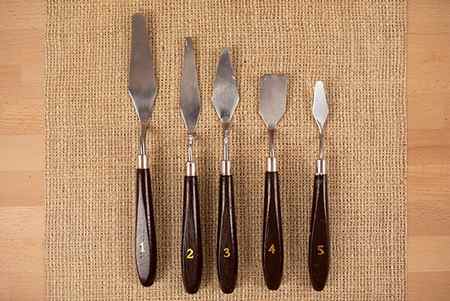
A painting knife or a palette knife (there is a slight difference but they can basically be used for the same purposes) is a great tool for painting with acrylic paint.
With it, you can mix paint as well as add paint to your surface while creating texture.
It usually creates a thick layer of paint or smudges the paint, but you can play around with it and see what you can achieve.
They’re easy to clean but you need to clean them right after using them because acrylic paint will get dry and then you’ll have problems getting it off.
For this, I use a paper towel or a cloth and just remove the wet paint with one move. It takes just a few seconds so it doesn’t take a lot of your precious time off actually painting.
Also, you can get painting/palette knives without spending a fortune.
If you still don’t have one but you’d like to try this style of painting, you can use an old credit or gift card. It can create similar or even the same effects as the painting knife.
Kitchen sponge

This is one of my all-time favorites to use for acrylic painting techniques. It’s amazing because:
- It’s cheap
- It’s easy to get
- It’s easy to replace
- You can reuse it over and over again
- It creates great texture when you dab with it
- You can cover a lot of areas, so they’re great for backgrounds
- They’re amazing for blending different colors
- You can use them in combination with stencils and this gives amazing results
Try out the sponge you have in your kitchen right now. Cut it out in 4 pieces (or more or fewer, depending on the size) and try dabbing with it or blending two colors together.
After you finish, if you want to reuse the sponge, wash it immediately. If you do so, you’ll be able to use it again. Otherwise, the paint will get dry and then the sponge is completely worthless.
Painting sponge
There are a number of art sponges you can buy specifically for painting. They look like sea sponges and you can create interesting textures with them.
You can use them like you’d use a kitchen sponge, but since their shape isn’t geometrical, they won’t leave hard edges while dabbing with them.
Masking tape
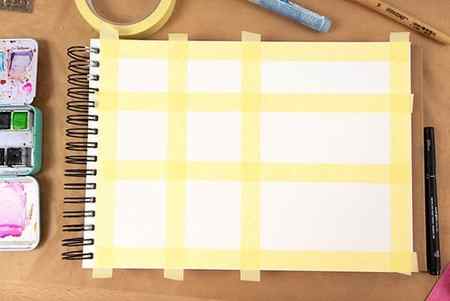
I don’t use this one often but it’s an interesting tool for a few reasons.
- Frame your page/paper so you get a nice white space/frame around your painting
- Play with it by creating shapes and then painting within the shapes. Then lift the tape and you’ll have great patterns or shapes
- Put straps of tape to secure the journaling space. After you’ve painted the page, remove the tape and you’ll have nice, white space to write on
Texture tools for acrylic paint
There are different texture tools for painting with acrylics, whether you buy them or just use things from your home.
You’ll mostly get texture if you apply a thick layer of paint and then create texture with some tools.
For example, a scraper can help make lines by picking up some paint.
There are amazing texture tools you can find in your home. I’ll share those below in the cheap tools section.
Binder clips

No, you don’t paint with them, but they’re useful tools to keep your art journal ages from moving while you paint.
I take a few pages and clip them together so that my journal stays flat the whole time, especially for small journals.
Gesso (not actually a tool, but…)
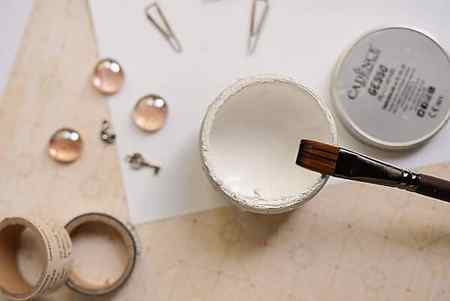
Gesso is not an acrylic painting tool, but it’s a great medium.
You use gesso to prime your page for painting. This was mostly used on canvases, but it’s very popular in the art journal community for a few reasons:
- When you cover your page with gesso first, acrylic paint also becomes richer in color
- If you have thin paper, gesso can help by securing no paint bleeds to the back of the paper
- You can use white or black gesso to cover “mistakes” you don’t like
Heat gun
A heat gun can be a life-saver. It’s like a very hot hairdryer but it doesn’t blow things away. You can use it to speed up the process of drying acrylic paint.
Just use it carefully because it can get really hot, and you mustn’t keep it in one place for a long time or the paint will turn into frying bubbles.
It takes just seconds to dry the paint, so don’t overuse it.
However, if you have time to wait for the paint to dry, you should do so. You see, while using the heat gun, some paint may have awful smells and you shouldn’t inhale that.
It’s just my thinking…if it smells bad, it’s not good for inhaling.
Acrylic painting tools and equipment
Design Course
Rendering Style for Illustration
Tools and Materials
Painting is a process of applying paints on a surface with the help of different tools.
An acrylic paint can be applied on dry and wax free surfaces like vessels, clothes, walls, etc. For application of this paint many tools like, brushes, knives, spatulas can be used. There are many types of papers, canvases, and boards available in the market.
Below are some of the tools and materials used for painting:
• Paint colors
• Brushes
• Canvases
• Knives and Spatulas
• Mixing palette
• An Easel

a. Paint colors:
To start painting, you need few basic colors like titanium blue, black, ultramarine blue, crimson red, yellow ochre. With the combination of these hues, most other paint colors can be made easily.

Now a days there are many pre mixed colors readily available in the market.

Acrylic paints come in several ranges from beginners to professionals and are available in bottles and tubes. At the beginner’s level it is preferable to buy small quantities in bottle or tubes, each bottle or tube might cost around 20-200 rupees each. There is not much of a difference between bottled and tube colors.
b. Brushes:
Choosing paintbrushes is a very important step in painting because it can totally change the look and feel of the painting, quality of strokes and texture. In the market there are many types of brushes available. They are mainly categorized into three types-rounded, flat and filbert brushes, depending upon the shape of the brush tip. Many different materials are used to make paintbrush bristles, the most common are synthetic and boar hair.

It is easier to use synthetic brushes in the beginning, as they are softer, finer, cheaper, and easy to clean. It is better to have different shaped and sized brushes depending on the painting requirement. For example 0 and 1 size round brushes are good for drawing fine outlines and detailing, where as flat brushes are useful in filling wider areas in a painting.
c. Canvases:
To start painting you will need a surface to apply paint on. Acrylic paints can be used on just about any surface you like. They provide nice visible textures on canvas. Canvas is available in many shapes and sizes and forms like canvas rolls, pads, boards and frames. Canvas pads and boards are comparatively cheaper than framed canvas. These canvases are already treated and processed and can be directly used for painting. Paper is also an easily available material around us, but for durability, longevity and quality it is better to use canvas for acrylic paintings.

d. Knives and Spatulas:
Palette knives are made of very flexible steel blade with no sharpened or cutting edge and have a wooden / plastic handle. They are used to mix colors and mediums.

Spatulas are comparatively blunt and less flexible steel blades with no sharpened cutting edge and wooden / plastic handle. They are used instead of a brush to apply paint directly on painting surface like canvas. They are available in many shapes, sizes and styles that give different effects and textures.
e. Mixing palette:
While painting you will need something to mix paints on or to store them for future use. For this any plastic or wooden plate or any wide, flat and clean surface can be used as mixing palette.
f. An Easel:
An Easel is a wooden upright support stand specially made for mounting a canvas board while painting.

- Introduction
- History
- Painters – Acrylic Paintings
- Painting Mediums
- Tools and Materials
- Getting Started
- Process
- Things to Remember
- Slide show
- Video
- Links and Reference
- Downloads
- Contact Details
- Credits





